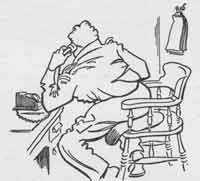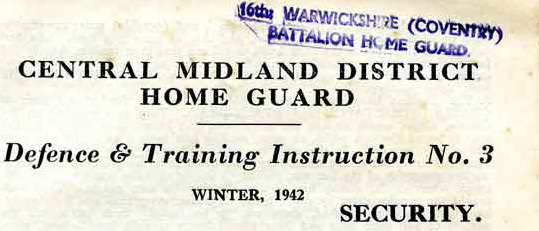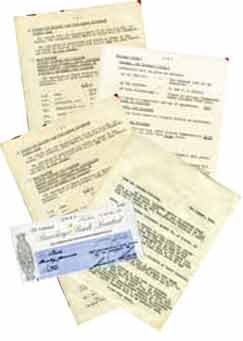|
GENERAL INFORMATION ON THE HOME GUARD
PAPERWORK, RED TAPE and BUMF
|
This
is a page of the
GENERAL INFORMATION ON THE HOME GUARD
section of www.staffshomeguard.co.uk.
Please go to Site
Map for complete site contents.
A view throughout the Home Guard was that as time went on the volume of paperwork appearing from 'on high' developed from the acceptable to the excessive and then finally to the ludicrous. It comprised instructions, demands and guidance, on everything from new defensive strategy and detailed tactics to the training associated with new weapons, from Battalion equipment returns to arguments over petty expenditure. Lt. Col. Cartwright of the 32nd Staffordshire wrote:
"I believe I am right in saying that our first Defence Orders from Sector in 1941 consisted of one or two pages of foolscap at the most. By the summer of 1942, however, the Higher Command had begun to develop theories on defensive tactics, and orders reached voluminous lengths...."
In one sense the increase in the amount of 'bumf' was perhaps understandable as the force became more professional with a wider range of weapons at its disposal and as external circumstances led to changes in strategy and tactics. And no doubt most of it had the force of logic behind it. The Home Guard was after all dealing with a huge responsibility, nothing less than the defence - or even survival - of the nation, and in pursuing this duty was  organising a vast number of individual men and spending an amount of Government
money – relatively tiny (see The Cost of the HG) and yet the latter WAS nevertheless Government money and therefore had to be accounted for in accordance with official rules. But it must have meant sometimes to harrassed C.O.s, Adjutants and other senior officers that the true function of the force, to be “out there”, fully trained and ready to meet the foe was in danger of being lost under a pile of paperwork and burdensome office work; and that those above them had little comprehension of or sympathy for the fact that they were in the main part-timers with day jobs and many other responsibilities. organising a vast number of individual men and spending an amount of Government
money – relatively tiny (see The Cost of the HG) and yet the latter WAS nevertheless Government money and therefore had to be accounted for in accordance with official rules. But it must have meant sometimes to harrassed C.O.s, Adjutants and other senior officers that the true function of the force, to be “out there”, fully trained and ready to meet the foe was in danger of being lost under a pile of paperwork and burdensome office work; and that those above them had little comprehension of or sympathy for the fact that they were in the main part-timers with day jobs and many other responsibilities.
These are the words of one contemporary commentator on the Home Guard:
“too much instructional paper - printed, cyclostyled, or typewritten - was produced and circulated. There seemed to be a paragraph and sub-paragraph to cover every tiniest event which could possibly happen, not only to every man, but to every buckle and bootlace. In consequence, the administration of Home Guard units tended to follow the placid, careful, and elaborate course of civil service routine, and many a man felt encouraged to take shelter behind an appropriate regulation rather than think and act for himself. But in fairness it must be admitted that this is an encumbrance the British Army has borne for many decades, and also that the bureaucratic disease, multiplying its malignant cells at the expense of healthy tissue, was not confined to the Home Guard - it has spread into every aspect of national life, and, indeed, into almost every aspect of our personal lives. Posterity may well wonder how we continued to fight the war at all, swathed in endless entanglements of red tape………...”
Commanding Officers had a constant struggle to restrict the burden on those further down the chain of command to an acceptable minimum. The heady, uncomplicated days of June 1940, when the overriding priority was to get men, equipped with an armband and whatever weapon was available, out into the streets and fields must have been a fond memory. But inevitably the demands of higher authority led to much internal paperwork within battalions. An HG historian, Norman Longmate, quotes a Berkshire Home Guard:
"Daily there descended upon us a shower of letters, forms, chits, returns and memos from Battalion H.Q. There were the usual military orders....There was the same old iron ration missing for eighteen months and doomed so to be for all eternity; the odd gaiter which was surplus to stores and which nobody would own; the slab of chocolate missing in a box of a hundred of its kind and which, after many moons, the Company QMS, in a flash of genius, wrote off with the unassailable alibi 'destroyed by mice'....."
In another battalion there is a description of protracted correspondence over a demand for repayment of the sum of 2½d (= 1p and even then just the cost of a stamp) improperly claimed on behalf of a HG officer who had been wrongly sold a first-class rail ticket.
And so the flow of orders, requests and guidelines continued and with them the chitties, requisitions, certificates, memos, standing orders, authorisations, applications, returns and all the rest. It would have been quite impossible to meet every requirement and sensible officers and NCOs must have made regular judgements as to what needed complying with and what did not. They and their comrades at Battalion, Company or Platoon level probably consoled themselves with the knowledge that they had done their best to meet the requirements of officialdom to the extent to which circumstances allowed and had balanced their priorities as sensibly as they could.
This vast mound of paperwork – it must have amounted to millions of pieces of paper – has largely vanished. Much must have been dumped as so much waste paper as adjutants and other staff wound down the organisation after stand-down. What survives are now collectors’ pieces. Many are personal items, such as proficiency certificates and other documents, issued to individual Home Guards and kept by them for the rest of their lives. A few such documents are to be seen throughout this website. Others are instructions from on high which hit Battalions and then filtered down, increasingly distilled, to Company, Platoon, Section and finally individual Home Guard. And still others are the bits of paper which kept a unit on the right professional, disciplinary, financial and administrative lines.
The associated pages in this section of the website give a few examples of this huge pile of paperwork, no doubt typical of their kind. See below to view them.
A whole other area of paperwork was of course that of training manuals and similar guidance, perhaps more welcome to individual Home Guards as they strove to improve their professionalism and effectiveness. For convenience these are discussed and demonstrated elsewhere in a separate section of this website: MANUALS, HANDBOOKS, GUIDANCE & TRAINING MATERIALS.
 |
An instruction received by the 16th Warwickshire (Coventry) Battalion on Defence and Training, Winter 1942.
(Click on image to read) |
A few examples of paperwork from a typical Battalion, the 54th Kent.
(Click on image to read) |
 |
(Documents by courtesy of Mick Ackrill)
|